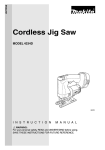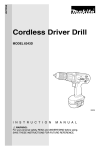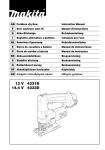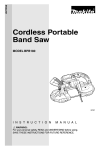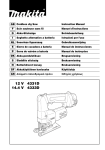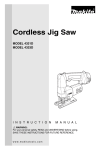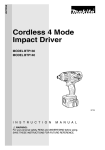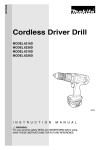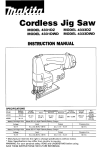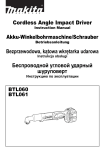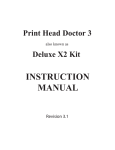Download Makita 4333D Specifications
Transcript
ENGLISH Cordless Jig Saw MODEL 4331D MODEL 4333D 002700 I N S T R U C T I O N M A N U A L WARNING: For your personal safety, READ and UNDERSTAND before using. SAVE THESE INSTRUCTIONS FOR FUTURE REFERENCE. SPECIFICATIONS Model 4331D Length of stroke Max. cutting capacities 4333D 26 mm Wood 65 mm Mild steel 10 mm Aluminum 20 mm -1 Strokes per minute (min ) 500 - 2,800 Overall length 500 - 2,600 280 mm Net weight 2.5 kg 2.9 kg Rated voltage D.C. 12 V D.C. 14.4 V • Due to our continuing programme of research and development, the specifications herein are subject to change without notice. • Note: Specifications may differ from country to country. For European countries only END001-1 Noise and Vibration Symbols The typical A-weighted sound pressure level is 81 dB (A). The following show the symbols used for the equipment. Uncertainty is 3 dB(A). Be sure that you understand their meaning before use. The noise level under working may exceed 85 dB (A). – Wear ear protection. – ..................Only for EU countries The typical weighted root mean square acceleration Do not dispose of electric equipment value is 9 m/s2. together with household waste These values have been obtained according to material! EN60745. In observance of European Directive 2002/96/EC on waste electric and EC-DECLARATION OF CONFORMITY electronic equipment and its We declare under our sole responsibility that this product implementation in accordance with is in compliance with the following standards of standnational law, electric equipment that ardized documents; have reached the end of their life EN60745, EN55014 in accordance with Council Direcmust be collected separately and tives, 89/336/EEC, 98/37/EC. returned to an environmentally compatible recycling facility. Yasuhiko Kanzaki CE2005 Intended use The tool is intended for the sawing of wood, plastic and metal materials. Director As a result of the extensive accessory and saw blade MAKITA INTERNATIONAL EUROPE LTD. program, the tool can be used for many purposes and is Michigan Drive, Tongwell, Milton Keynes, Bucks MK15 very well suited for curved or circular cuts. 8JD, ENGLAND Responsible manufacturer: Makita Corporation Anjo Aichi Japan 2 GENERAL SAFETY RULES GEA002-3 WARNING: Read all instructions. Failure to follow all instructions listed below may result in electric shock, fire and/or serious injury. The term “power tool” in all of the warnings listed below refers to your mains-operated (corded) power tool or batteryoperated (cordless) power tool. SAVE THESE INSTRUCTIONS Work area safety 1. Keep work area clean and well lit. Cluttered and dark areas invite accidents. 2. Do not operate power tools in explosive atmospheres, such as in the presence of flammable liquids, gases or dust. Power tools create sparks which may ignite the dust or fumes. 3. Keep children and bystanders away while operating a power tool. Distractions can cause you to lose control. Electrical safety 4. Power tool plugs must match the outlet. Never modify the plug in any way. Do not use any adapter plugs with earthed (grounded) power tools. Unmodified plugs and matching outlets will reduce risk of electric shock. 5. Avoid body contact with earthed or grounded surfaces such as pipes, radiators, ranges and refrigerators. There is an increased risk of electric shock if your body is earthed or grounded. 6. Do not expose power tools to rain or wet conditions. Water entering a power tool will increase the risk of electric shock. 7. Do not abuse the cord. Never use the cord for carrying, pulling or unplugging the power tool. Keep cord away from heat, oil, sharp edges or moving parts. Damaged or entangled cords increase the risk of electric shock. 8. When operating a power tool outdoors, use an extension cord suitable for outdoor use. Use of a cord suitable for outdoor use reduces the risk of electric shock. Personal safety 9. Stay alert, watch what you are doing and use common sense when operating a power tool. Do not use a power tool while you are tired or under the influence of drugs, alcohol or medication. A moment of inattention while operating power tools may result in serious personal injury. 10. Use safety equipment. Always wear eye protection. Safety equipment such as dust mask, non-skid safety shoes, hard hat, or hearing protection used for appropriate conditions will reduce personal injuries. 11. Avoid accidental starting. Ensure the switch is in the off-position before plugging in. Carrying power tools with your finger on the switch or plugging in power tools that have the switch on invites accidents. 12. Remove any adjusting key or wrench before turning the power tool on. A wrench or a key left attached to a rotating part of the power tool may result in personal injury. 13. Do not overreach. Keep proper footing and balance at all times. This enables better control of the power tool in unexpected situations. 14. Dress properly. Do not wear loose clothing or jewellery. Keep your hair, clothing, and gloves away from moving parts. Loose clothes, jewellery or long hair can be caught in moving parts. 15. If devices are provided for the connection of dust extraction and collection facilities, ensure these are connected and properly used. Use of these devices can reduce dust-related hazards. Power tool use and care 16. Do not force the power tool. Use the correct power tool for your application. The correct power tool will do the job better and safer at the rate for which it was designed. 17. Do not use the power tool if the switch does not turn it on and off. Any power tool that cannot be controlled with the switch is dangerous and must be repaired. 18. Disconnect the plug from the power source and/ or the battery pack from the power tool before making any adjustments, changing accessories, or storing power tools. Such preventive safety measures reduce the risk of starting the power tool accidentally. 19. Store idle power tools out of the reach of children and do not allow persons unfamiliar with the power tool or these instructions to operate 3 the power tool. Power tools are dangerous in the hands of untrained users. 20. Maintain power tools. Check for misalignment or binding of moving parts, breakage of parts and any other condition that may affect the power tools operation. If damaged, have the power tool repaired before use. Many accidents are caused by poorly maintained power tools. 21. Keep cutting tools sharp and clean. Properly maintained cutting tools with sharp cutting edges are less likely to bind and are easier to control. 22. Use the power tool, accessories and tool bits etc. in accordance with these instructions and in the manner intended for the particular type of power tool, taking into account the working conditions and the work to be performed. Use of the power tool for operations different from those intended could result in a hazardous situation. Battery tool use and care 23. Ensure the switch is in the off position before inserting battery pack. Inserting the battery pack into power tools that have the switch on invites accidents. 24. Recharge only with the charger specified by the manufacturer. A charger that is suitable for one type of battery pack may create a risk of fire when used with another battery pack. 25. Use power tools only with specifically designated battery packs. Use of any other battery packs may create a risk of injury and fire. 26. When battery pack is not in use, keep it away from other metal objects like paper clips, coins, keys, nails, screws, or other small metal objects that can make a connection from one terminal to another. Shorting the battery terminals together may cause burns or a fire. 27. Under abusive conditions, liquid may be ejected from the battery, avoid contact. If contact accidentally occurs, flush with water. If liquid contacts eyes, additionally seek medical help. Liquid ejected from the battery may cause irritation or burns. Service 28. Have your power tool serviced by a qualified repair person using only identical replacement parts. This will ensure that the safety of the power tool is maintained. 29. Follow instruction for lubricating and changing accessories. 30. Keep handles dry, clean and free from oil and grease. 4 GEB016-1 SPECIFIC SAFETY RULES DO NOT let comfort or familiarity with product (gained from repeated use) replace strict adherence to jig saw safety rules. If you use this tool unsafely or incorrectly, you can suffer serious personal injury. 1. Hold power tools by insulated gripping surfaces when performing an operation where the cutting tool may contact hidden wiring or its own cord. Contact with a “live” wire will make exposed metal parts of the tool “live” and shock the operator. 2. Use clamps or another practical way to secure and support the workpiece to a stable platform. Holding the work by hand or against your body leaves it unstable and may lead to loss of control. 3. Always use safety glasses or goggles. Ordinary eye or sun glasses are NOT safety glasses. 4. Avoid cutting nails. Inspect workpiece for any nails and remove them before operation. 5. Do not cut oversize workpiece. 6. Check for the proper clearance beyond the workpiece before cutting so that the blade will not strike the floor, workbench, etc. 7. Hold the tool firmly. 8. Make sure the blade is not contacting the workpiece before the switch is turned on. 9. Keep hands away from moving parts. 10. Do not leave the tool running. Operate the tool only when hand-held. 11. Always switch off and wait for the blade to come to a complete stop before removing the blade from the workpiece. 12. Do not touch the blade or the workpiece immediately after operation; they may be extremely hot and could burn your skin. 13. Do not operate the tool at no-load unnecessarily. 14. Some material contains chemicals which may be toxic. Take caution to prevent dust inhalation and skin contact. Follow material supplier safety data. 15. Always use the correct dust mask/respirator for the material and application you are working with. SAVE THESE INSTRUCTIONS. WARNING: MISUSE or failure to follow the safety rules stated in this instruction manual may cause serious personal injury. IMPORTANT SAFETY INSTRUCTIONS FOR BATTERY CARTRIDGE 1. Do not disassemble battery cartridge. 3. If operating time has become excessively shorter, stop operating immediately. It may result in a risk of overheating, possible burns and even an explosion. 4. 5. 6. (1) Do not touch the terminals with any conductive material. Before using battery cartridge, read all instructions and cautionary markings on (1) battery charger, (2) battery, and (3) product using battery. 2. ENC004-1 (2) Avoid storing battery cartridge in a container with other metal objects such as nails, coins, etc. (3) Do not expose battery cartridge to water or rain. A battery short can cause a large current flow, overheating, possible burns and even a breakdown. If electrolyte gets into your eyes, rinse them out with clear water and seek medical attention right away. It may result in loss of your eyesight. 7. Always cover the battery terminals with the battery cover when the battery cartridge is not used. Do not store the tool and battery cartridge in locations where the temperature may reach or exceed 50°C (122°F). 8. Do not incinerate the battery cartridge even if it is severely damaged or is completely worn out. The battery cartridge can explode in a fire. 9. Be careful not to drop or strike battery. Do not short the battery cartridge: SAVE THESE INSTRUCTIONS Tips for maintaining maximum battery life 1. Charge the battery cartridge before completely discharged. Always stop tool operation and charge the battery cartridge when you notice less tool power. 2. Never recharge a fully charged battery cartridge. Overcharging shortens the battery service life. 3. Charge the battery cartridge with room temperature at 10°C - 40°C (50°F - 104°F). Let a hot battery cartridge cool down before charging it. 4. Charge the Nickel Metal Hydride battery cartridge when you do not use it for more than six months. 5 FUNCTIONAL DESCRIPTION • 002702 Installing or removing battery cartridge • • • 1 2 • 1. Button 2. Battery cartridge CAUTION: Always be sure that the tool is switched off and the battery cartridge is removed before adjusting or checking function on the tool. Always switch off the tool before insertion or removal of the battery cartridge. To remove the battery cartridge, withdraw it from the tool while pressing the buttons on both sides of the cartridge. To insert the battery cartridge, align the tongue on the battery cartridge with the groove in the housing and slip it into place. Always insert it all the way until it locks in place with a little click. If not, it may accidentally fall out of the tool, causing injury to you or someone around you. Do not use force when inserting the battery cartridge. If the cartridge does not slide in easily, it is not being inserted correctly. 002705 Selecting the cutting action 1 This tool can be operated with an orbital or a straight line (up and down) cutting action. The orbital cutting action thrusts the blade forward on the cutting stroke and greatly increases cutting speed. To change the cutting action, just turn the cutting action changing lever to the desired cutting action position. Refer to the table to select the appropriate cutting action. 1. Cutting action changing lever 002788 Position Cutting action 0 Straight line cutting action I Small orbit cutting action II Medium orbit cutting action III Large orbit cutting action 002708 1 Switch action CAUTION: Before inserting the battery cartridge into the tool, always check to see that the switch trigger actuates properly and returns to the “OFF” position when released. To prevent the switch trigger from being accidentally pulled, a lock-off button is provided. To start the tool, push in the lock-off button and pull the switch trigger. Release the switch trigger to stop. • 2 1. Lock-off button 2. Switch trigger 6 Applications For cutting mild steel, stainless steel and plastics. For clean cuts in wood and plywood. For cutting mild steel, aluminum and hard wood. For cutting wood and plywood. For fast cutting in aluminum and mild steel. For fast cutting in wood and plywood. 002711 1 Speed adjusting dial The tool speed can be infinitely adjusted between 500 and 2,800 (Model 4331D), 500 and 2,600 (Model 4333D) strokes per minute by turning the adjusting dial. Higher speed is obtained when the dial is turned in the direction of number 5; lower speed is obtained when it is turned in the direction of number 1. Refer to the table to select the proper speed for the workpiece to be cut. However, the appropriate speed may differ with the type or thickness of the workpiece. In general, higher speeds will allow you to cut workpieces faster but the service life of the blade will be reduced. 1. Speed adjusting dial 002790 Workpiece to be cut Wood Mild steel Stainless steel Aluminum Plastics • • ASSEMBLY • Number on adjusting dial 3-5 3-5 3-4 2-3 1-4 CAUTION: If the tool is operated continuously at low speeds for a long time, the motor will get overloaded and heated up. The speed adjusting dial can be turned only as far as 5 and back to 1. Do not force it past 5 or 1, or the speed adjusting function may no longer work. CAUTION: Always be sure that the tool is switched off and the battery cartridge is removed before carrying out any work on the tool. Installing or removing saw blade 002717 CAUTION: Always clean out all chips or foreign matter adhering to the blade and/or blade holder. Failure to do so may cause insufficient tightening of the blade, resulting in a serious personal injury. • Do not touch the blade or the workpiece immediately after operation; they may be extremely hot and could burn your skin. • Always secure the blade firmly. Insufficient tightening of the blade may cause blade breakage or serious personal injury. To install the blade, loosen the screw counterclockwise on the blade holder with the hex wrench. • 1 2 1. Screw 2. Hex wrench 7 002718 1 2 With the blade teeth facing forward, insert the blade into the blade holder as far as it will go. Make sure that the back edge of the blade fits into the roller. Then tighten the screw clockwise to secure the blade. To remove the blade, follow the installation procedure in reverse. NOTE: • Occasionally lubricate the roller. 3 1. Screw 2. Roller 3. Jig saw blade 004445 If the universal blade clamp is used, you can use blades of other makes which have a universal shank like the one shown in the figure, with a blade width of 6.35 mm. 6.35mm 1 Installing the universal shank jig saw blade 002726 Insert the blade into the blade holder as far as it will go. Make sure that the end of the blade shank reaches the bottom of the inner slit and tighten the bolt securely with the hex wrench. 002733 Anti-splintering device 2 1. Blade holder 2. Bolt For splinter-free cuts, the anti-splintering device can be used. To install the anti-splintering device, move the base all the way forward and fit it into the base from the back of base. NOTE: 1 2 1. Base 2. Anti-splintering device 8 • The anti-splintering device cannot be used when making bevel cuts. 002735 Plastic base plate (optional accessory) Use the plastic base plate when cutting decorative veneers, plastics, etc. It protects sensitive surfaces from damage. To replace the base plate, remove the four screws. 1 2 3 1. Screw 2. Plastic base plate 3. Hex wrench 002737 Rip fence (optional accessory) When cutting widths of under 150 mm repeatedly, use of the rip fence (guide rule) will assure fast, clean, straight cuts. To install it, loosen the bolt on the front of the base. Slip in the rip fence and secure the bolt. 1 2 3 1. Hex wrench 2. Rip fence (Guide rule) 3. Bolt 002739 Circular guide (optional accessory) Use of the circular guide insures clean, smooth cutting of circles under 200 mm in radius. Insert the pin through the center hole and secure it with the threaded knob. Move the base of the tool forward fully. Then install the circular guide on the base in the same manner as the rip fence (guide rule). 1 2 3 1. Threaded knob 2. Circular guide 3. Pin 002740 1 Plastic cover and vacuum head (optional accessory) The vacuum head is recommended to perform clean cutting operations. Install the plastic cover on the tool by fitting it into the notches in the tool. 2 3 1. Notches 2. Base 3. Plastic cover 9 002741 1 To attach the vacuum head on the tool, insert the hooks of the vacuum head into the hole in the base. The vacuum head can be installed on either left or right side of the base. Then connect a Makita vacuum cleaner to the vacuum head. 2 1. Vacuum head 2. Base 002742 OPERATION • • 002744 CAUTION: Always hold the base flush with the workpiece. Failure to do so may cause blade breakage, resulting in a serious injury. Advance the tool very slowly when cutting curves or scrolling. Forcing the tool may cause a slanted cutting surface and blade breakage. Turn the tool on without the blade making any contact and wait until the blade attains full speed. Then rest the base flat on the workpiece and gently move the tool forward along the previously marked cutting line. NOTE: 1 • If the tool is operated continuously until the battery cartridge has discharged, allow the tool to rest for 15 minutes before proceeding with a fresh battery. 2 1. Cutting line 2. Base 002751 Bevel cutting CAUTION: Always be sure that the tool is switched off and the battery cartridge is removed before tilting the base. With the base tilted, you can make bevel cuts at any angle between 0° and 45° (left or right). • 10 002752 3 1 Loosen the bolt on the back of the base with the hex wrench. Move the base so that the bolt is positioned in the center of the cross-shaped slot in the base. 2 1. Cross-shaped slot 2. Hex wrench 3. Bolt 002753 Tilt the base until the desired bevel angle is obtained. The edge of the motor housing indicates the bevel angle by graduations. Then tighten the bolt to secure the base. 002758 Front flush cuts 1 2 3 1. Edge of motor housing 2. Graduations 3. Base Loosen the bolt on the back of the base with the hex wrench and slide the base all the way back. Then tighten the bolt to secure the base. Cutouts Cutouts can be made with either of two methods A or B. 002763 A) Boring a starting hole For internal cutouts without a lead-in cut from an edge, pre-drill a starting hole 12 mm or more in diameter. Insert the blade into this hole to start your cut. 1 1. Starting hole 11 002764 B) Plunge cutting You need not bore a starting hole or make a lead-in cut if you carefully do as follows. (1) Tilt the tool up on the front edge of the base with the blade point positioned just above the workpiece surface. (2) Apply pressure to the tool so that the front edge of the base will not move when you switch on the tool and gently lower the back end of the tool slowly. (3) As the blade pierces the workpiece, slowly lower the base of the tool down onto the workpiece surface. (4) Complete the cut in the normal manner. 002769 Finishing edges To trim edges or make dimensional adjustments, run the blade lightly along the cut edges. Metal cutting Always use a suitable coolant (cutting oil) when cutting metal. Failure to do so will cause significant blade wear. The underside of the workpiece can be greased instead of using a coolant. MAINTENANCE • 001145 CAUTION: Always be sure that the tool is switched off and the battery cartridge is removed before attempting to perform inspection or maintenance. Replacing carbon brushes Remove and check the carbon brushes regularly. Replace when they wear down to the limit mark. Keep the carbon brushes clean and free to slip in the holders. Both carbon brushes should be replaced at the same time. Use only identical carbon brushes. 1 1. Limit mark 002785 1 2 1. Brush holder cap 2. Screwdriver 12 Use a screwdriver to remove the brush holder caps. Take out the worn carbon brushes, insert the new ones and secure the brush holder caps. To maintain product SAFETY and RELIABILITY, repairs, any other maintenance or adjustment should be performed by Makita Authorized Service Centers, always using Makita replacement parts. ACCESSORIES CAUTION: These accessories or attachments are recommended for use with your Makita tool specified in this manual. The use of any other accessories or attachments might present a risk of injury to persons. Only use accessory or attachment for its stated purpose. If you need any assistance for more details regarding these accessories, ask your local Makita service center. • • • • • • Jig saw blades Various type of Makita genuine batteries and chargers Hex wrench 3 Rip fence (guide rule) Circular guide • • • • • Plastic base plate Anti-splintering device Plastic cover Vacuum head Hose (For vacuum cleaner) 13 Memo 14 Memo 15 Makita Corporation Anjo, Aichi, Japan 884339C223
















